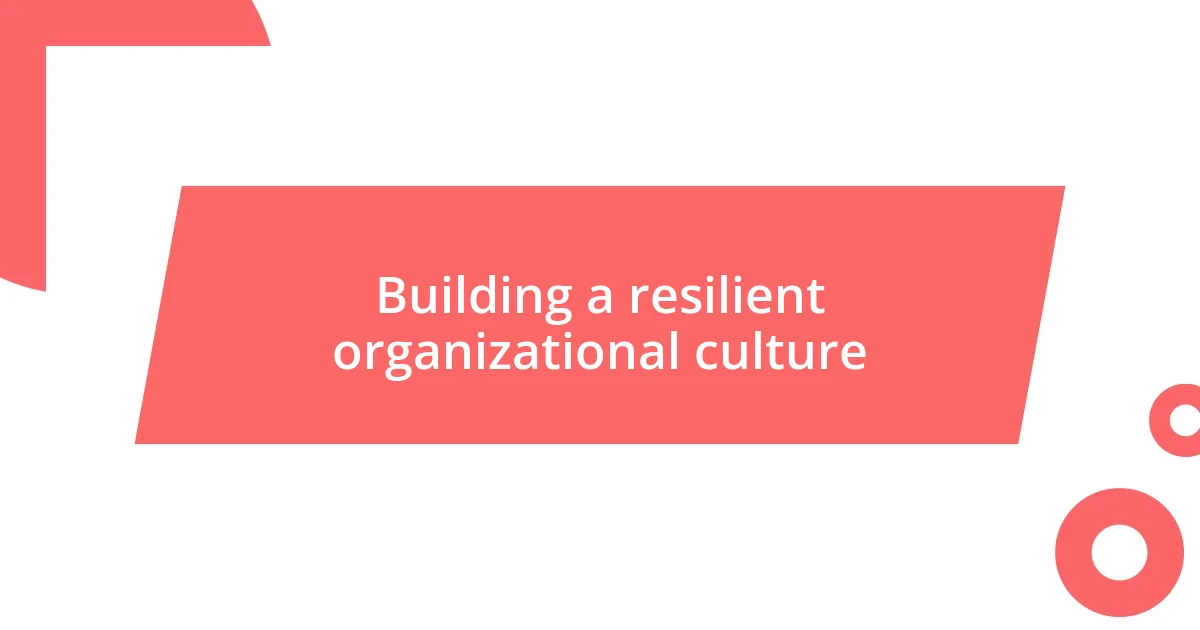Key takeaways:
- Emphasizing adaptability and relationship-building as core principles for sustainable long-term growth.
- Defining clear, specific, measurable, and time-bound objectives enhances focus and motivates strategic actions.
- Fostering a resilient organizational culture through open communication, empowerment, and shared vision drives innovation and adapts to market changes.

Understanding long-term growth strategies
Long-term growth strategies are all about envisioning the future while rooted in a solid foundation. I’ve often found that when I take the time to analyze market trends and consumer behaviors, it becomes clear that adaptability is key. How often have you seen companies resist change, only to falter later on? That’s why I prioritize building a flexible framework that allows for spontaneous growth, rather than a rigid one that could stifle innovation.
When I think about the long-term strategies I’ve successfully implemented, a core principle stands out: invest in relationships. For instance, I recall a time when I nurtured a nascent partnership with an unexpected collaborator. The payoff wasn’t immediate, but over time, that relationship blossomed into a vital resource, enriching both our business landscapes. This experience has taught me that harnessing genuine connections can lead to sustainable growth, even when immediate results are elusive.
Moreover, I believe that understanding your audience is central to crafting effective strategies. I vividly remember conducting a customer feedback session that unexpectedly unveiled insights I had overlooked. Their honest opinions helped me pivot my approach, ultimately leading to enhanced loyalty and growth. Isn’t it fascinating how listening to those we serve can transform our paths forward? Embracing this feedback allows for the creation of tailored solutions that resonate deeply with our audience, ensuring that growth is not only sustained but also aligned with their evolving needs.

Defining clear growth objectives
Defining clear growth objectives may seem straightforward, but I’ve learned that specificity is key to making them effective. Setting objectives that are measurable and realistic allows me to assess progress accurately. I recall a time when I simply aimed for “increased sales” without a target—my efforts felt vague and directionless. After that experience, I switched gears to define goals such as “increase sales by 20% in six months.” This shift transformed my approach, guiding my actions with precision.
When outlining these objectives, I often rely on a framework that helps clarify my goals. Here’s what I focus on:
- Specific: Identify precisely what I want to achieve.
- Measurable: Ensure that I can quantify progress and outcomes.
- Achievable: Goals should be attainable within the set timeframe and resources.
- Relevant: Align objectives with my broader strategic vision and market needs.
- Time-bound: Establish a clear deadline for each goal to maintain urgency and accountability.
Each element contributes to a cohesive strategy, empowering me to stay focused and motivated. By defining objectives with this clarity, I can navigate uncertainties with confidence, drawing motivation from every milestone I hit along the way.

Analyzing market trends and risks
Market trends are like the currents of a river; they shape the environment in which we operate. Personally, I’ve seen how a deep dive into data analysis can reveal insights that might initially seem hidden. For instance, during a challenging project, I noticed a decline in consumer interest around certain products. By analyzing sales trends and social media feedback, I realized that shifting consumer preferences were at play. This experience reinforced the importance of staying ahead of the curve, allowing informed adjustments to our strategy based on real-time market fluctuations.
Understanding risks doesn’t just mean identifying potential pitfalls; it’s about anticipating them with an analytical mindset. I remember a time when my team faced an unexpected market shift—competitors were launching new technologies that threatened our position. Rather than panicking, we conducted a risk assessment that included evaluating industry reports and competitor analysis. We developed a contingency plan that not only mitigated risks but also turned a potential setback into an opportunity for innovation. This taught me that embracing risk analysis can lead to growth, provided you approach it with strategic foresight.
In my experience, the balance between analyzing trends and recognizing risks is crucial for informed decision-making. I often utilize a combination of quantitative metrics and qualitative insights to form a comprehensive picture. For example, while analyzing quarterly financials provides the numbers, engaging with customer sentiments unlocks the real emotions driving those figures. This dual approach has not only aided in strategy formulation but also fostered an adaptive mindset within my team, encouraging us to be both proactive and responsive in our long-term growth endeavors.
| Market Trends | Risks |
|---|---|
| Insights into consumer behaviors | Potential pitfalls and setbacks |
| Data analysis for informed decisions | Contingency planning and adaptability |
| Engaging with real-time feedback | Evaluating technological disruptions |

Developing a scalable business model
When developing a scalable business model, I always seek to ensure that my core processes are as efficient as possible. For instance, I remember when I needed to streamline our customer service system. Initially, our approach was entirely manual, which resulted in delays and frustration for both customers and staff. By integrating automation tools, we not only reduced resolution times but also elevated customer satisfaction—proof that efficiency can fuel growth.
As I think about scalability, I also consider the product or service lifecycle. I fondly recall a particular product launch that encountered unforeseen challenges, mainly due to a rigid pricing strategy. It took a heartfelt conversation with my team to pivot our approach, allowing for tiered pricing and added features that appealed to various customer segments. By being adaptable, we opened the door for different markets, showcasing how flexibility in my model directly led to increased revenue. Doesn’t it feel empowering to know that a slight adjustment can unlock new avenues for growth?
Moreover, understanding the importance of leveraging technology cannot be understated. I’ve seen firsthand how digital platforms can enhance my reach exponentially. A couple of years back, I immersed myself in e-commerce solutions, enabling my business to cater to customers beyond our local market. This leap not only expanded our customer base but also added a layer of resilience that makes my business model much more sustainable. Isn’t it fascinating how technology can act as a catalyst for scalable growth? By consciously designing a model that embraces these factors, I believe success becomes not just a possibility, but a probable outcome.

Implementing effective marketing techniques
Implementing effective marketing techniques is vital for long-term growth. I once experimented with varied content strategies for social media and was surprised by how much engagement the casual, behind-the-scenes posts generated. They not only fostered a sense of community but also humanized our brand, connecting us more deeply with our audience. Isn’t it intriguing how authenticity can resonate more than polished marketing pitches?
I’ve also learned the power of targeted campaigns. One memorable campaign I rolled out was focused on a specific demographic that we had previously overlooked. By crafting tailored messages that spoke directly to their interests, engagement skyrocketed—it reminded me that sometimes, listening to your audience’s voice can yield incredible results. Have you ever noticed how understanding your customer’s journey can open unexpected doors?
Data-driven decisions have been pivotal for me too. After launching an online ad campaign, I carefully analyzed the metrics and discovered which channels were generating the most leads. It became evident that A/B testing had to be a regular practice, helping us refine our approach continuously. Seeing those numbers shift in our favor was exhilarating—a testament to how effective marketing techniques, grounded in data, directly influence growth. Do you find that empowering? Knowing that the right strategy can lead to untapped potential is a game-changer in any growth endeavor.

Measuring growth and adapting strategies
Measuring growth is more than just tracking numbers—it’s about understanding the narrative behind those figures. I remember launching a new product and gathering feedback from early users. Some of their insights were eye-opening, revealing not just what they liked but also the obstacles they faced. This kind of qualitative data made me realize that growth isn’t solely about sales but about genuine connection with customers. Have you ever had a moment where feedback turned your whole perspective?
Adapting strategies based on analysis is essential. Once, after evaluating our quarterly performance, I noticed a dip in a specific market segment. Instead of panicking, I gathered my team for a brainstorming session. We reimagined our approach by developing a workshop series tailored to those customers, which reignited their interest and led to a significant uptick in engagement. It’s fascinating how a bit of recalibration can breathe new life into stagnant areas. Isn’t it inspiring to see how flexibility can pave the road to recovery?
Lastly, I’ve found that growth isn’t static. After implementing new strategies, I always set aside time to review our progress regularly. For instance, when our online sales surged, I didn’t just celebrate; I analyzed what had shifted in our approach. Monitoring trends and customer behaviors helped me pivot quickly when necessary. How often do you check in on your own progress? This ongoing reflection ensures that I’m not just growing, but evolving with my audience, and it’s downright exhilarating.

Building a resilient organizational culture
Building a resilient organizational culture requires intentionality and a shared vision. I remember when our team faced a significant challenge due to a sudden shift in market demand. Rather than letting stress take hold, we gathered for a team retreat to openly discuss our concerns and dreams. That experience not only solidified our bond but also sparked innovative ideas that propelled us forward. Have you ever experienced a moment when vulnerability created the strongest connections?
Empowerment is another cornerstone of a robust culture. I’ve seen firsthand how giving team members the autonomy to make decisions fosters a sense of ownership. One time, a colleague took the lead on a project that had been stalled for months. His creativity and passion turned it into one of our most successful initiatives. The pride we all felt was palpable—doesn’t it make you realize how trust can unlock incredible potential?
Lastly, I’ve learned that open communication is vital for resilience. During a reorganization, I initiated regular check-ins to allow everyone to voice their thoughts and feelings. This practice not only alleviated anxiety but also encouraged fresh perspectives on our challenges. What surprised me was how feedback flowed both ways; we became a team that not only gave advice but also listened intently to each other. Isn’t it profound how transparency can turn uncertainty into opportunity?













